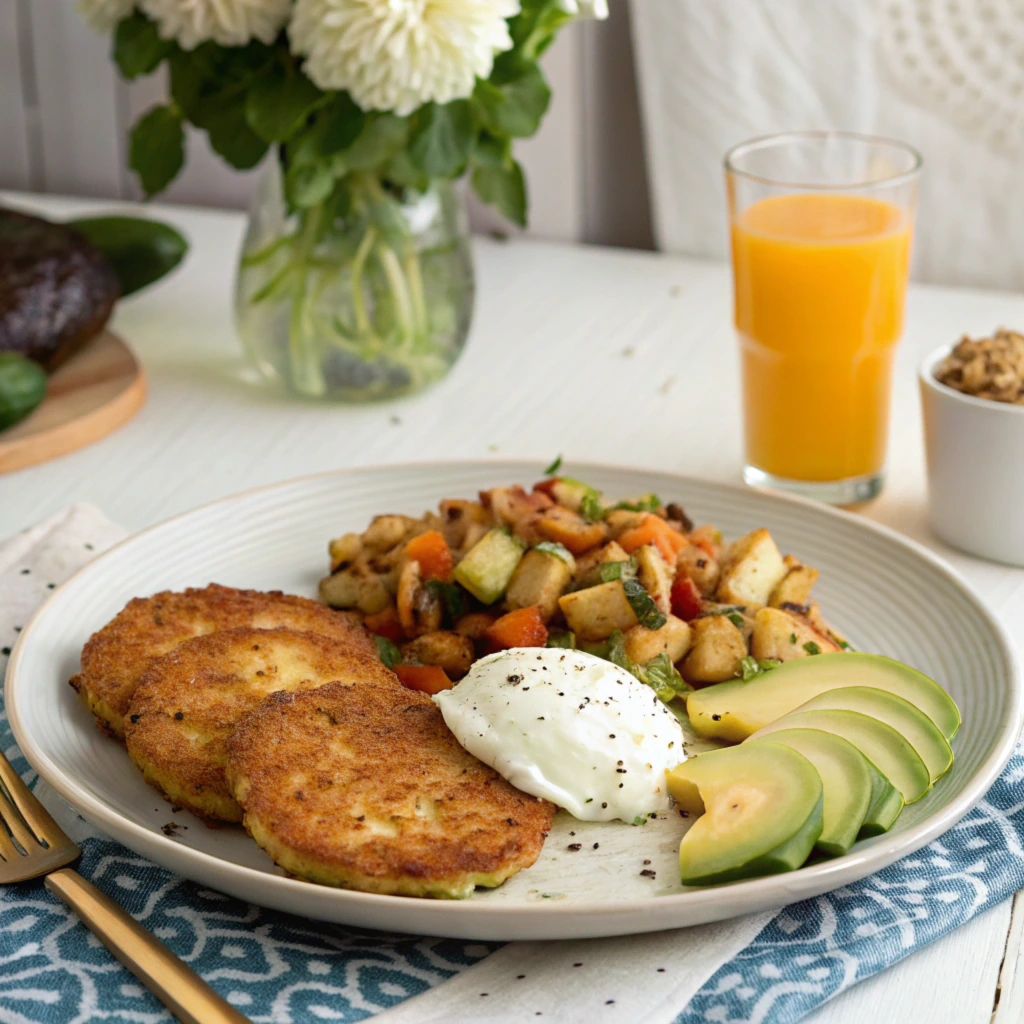Hash browns, a classic breakfast staple, are loved for their crispy texture and comforting taste. But are they truly a healthy addition to your plate? This article dives deep into the nutritional value of hash browns, their potential health benefits, and ways to make them healthier. Whether you’re a fan of the traditional deep-fried version or curious about lighter, homemade recipes, you’ll discover insights and tips to enjoy hash browns guilt-free.

What Are Hash Browns and Their Nutritional Composition?
Hash browns are more than just a breakfast side—they’re a versatile dish that can be prepared in various ways. Let’s explore their origins, nutritional makeup, and how additional ingredients can impact their healthiness.
What Are Hash Browns?
Hash browns are a dish made from grated or diced potatoes that are fried until crispy and golden brown. Originating from the United States, this humble dish became a breakfast icon for its simplicity and rich flavor. While traditionally made with potatoes and oil, modern variations include healthier alternatives such as baking or air-frying.
Nutritional Profile of Potatoes
At the heart of hash browns lies the potato—a vegetable packed with essential nutrients. Potatoes are a great source of:
- Vitamin C, which boosts immunity and skin health.
- Potassium, crucial for muscle function and blood pressure regulation.
- Dietary fiber, aiding digestion and keeping you full longer.
Moreover, potatoes are naturally low in calories and fat-free, making them an excellent base for a healthy meal.
Additional Ingredients in Hash Browns
What makes or breaks the health value of hash browns is how they’re prepared. Adding large amounts of oil, butter, or salt can turn this simple dish into a calorie-dense, high-fat food. On the other hand, using minimal oil or alternative cooking methods can preserve the potato’s nutritional benefits while keeping the dish light and flavorful.
In this section, we’ve laid the foundation for understanding hash browns and their core ingredients. But there’s much more to uncover! Next, we’ll discuss their health benefits and how they can fit into a balanced diet.
Health Benefits of Hash Browns

When prepared thoughtfully, hash browns can offer several health benefits. Let’s uncover how they contribute to a nutritious diet, depending on their preparation and ingredients.
Source of Key Nutrients
Hash browns, made primarily from potatoes, are packed with important nutrients that support overall health. Potatoes are a rich source of:
- Vitamin C, which strengthens the immune system.
- Vitamin B6, which aids in energy metabolism.
- Potassium, helping regulate blood pressure and maintain fluid balance.
These nutrients make hash browns a nutritious addition to your breakfast, especially when paired with other wholesome foods.
Hash Browns as an Energy Source
Potatoes are high in complex carbohydrates, which are the body’s main fuel source. Eating hash browns provides sustained energy throughout the day, making them an excellent choice for active individuals. If you’ve got a long day ahead, this crispy favorite can help you power through. That said, controlling portion size and preparation methods is essential to avoid unnecessary calories.
Homemade vs. Store-Bought Options
Not all hash browns are created equal! Homemade versions allow for better control over ingredients, making it easier to create a dish that aligns with your health goals. Store-bought hash browns, on the other hand, often come with added preservatives, high sodium content, and unhealthy fats. By opting for fresh ingredients and healthier cooking methods at home, you can enjoy hash browns without compromising on nutrition.
Potential Health Concerns
Although hash browns can be a good source of nutrients, they also have some potential drawbacks, especially when prepared traditionally. Here’s what to keep in mind.
High Calorie Content
Traditional hash browns are often deep-fried in oil, significantly increasing their calorie count. A single serving can quickly add up, especially when paired with other calorie-dense breakfast items. This makes it vital to moderate portion sizes if you’re watching your weight.
Oil and Fat Considerations
The type of oil used for frying plays a big role in the healthiness of hash browns. While some oils like olive or avocado oil provide healthier fats, others, like vegetable or canola oil, can increase the dish’s trans fat content. Choosing cooking methods like baking or air-frying can help cut back on excess fat while keeping your hash browns crisp and delicious.
Sodium Levels in Processed Hash Browns
Store-bought hash browns are often loaded with sodium to enhance flavor and preserve freshness. Consuming too much sodium can lead to issues like high blood pressure, especially when eaten regularly. By preparing hash browns at home, you can control salt levels and avoid this hidden danger.
In summary, hash browns can be both healthy and indulgent, depending on how they’re made. Adjusting preparation methods, ingredients, and portion sizes can help minimize their downsides while keeping their benefits intact.
Making Hash Browns Healthier
Hash browns can be transformed into a more nutritious dish by using simple tweaks and healthier preparation techniques. Let’s look at how you can enjoy them guilt-free.
Healthy Cooking Methods
Switching from frying to baking or air-frying is one of the easiest ways to cut down on fat and calories. Air-fried hash browns retain their crispy texture without requiring much oil. Baking is another excellent option that ensures an even cook while keeping the dish lighter. For detailed steps and tips on using an air fryer for hash browns, check out Hash Browns in Air Fryer.
Choosing Nutrient-Dense Ingredients
Elevate your hash browns by mixing in nutrient-rich additions like sweet potatoes, zucchini, or spinach. Not only do these ingredients enhance the flavor, but they also provide extra vitamins and fiber. Using whole, unprocessed potatoes instead of pre-packaged ones ensures a cleaner, more natural dish.
Using Less Oil and Salt
To make your hash browns healthier, reduce the oil and salt during preparation. A light spray of cooking oil is often enough to achieve that golden-brown crispness. Instead of salt, experiment with herbs and spices like paprika, garlic powder, or parsley for a flavor-packed dish that’s kinder to your heart. Learn more about the best choices for cooking oil or butter in Fry Hash Browns with Butter or Oil.
Comparing Hash Browns to Other Breakfast Foods
When it comes to breakfast, everyone has their favorite go-to options. Hash browns are a beloved classic, but how do they stack up against other popular choices? Let’s compare their nutritional value, versatility, and role in creating a balanced meal.
Hash Browns vs. Traditional Breakfast Items
Hash browns are made from potatoes, which are naturally low in fat and high in complex carbohydrates, making them an excellent source of energy. When cooked with minimal oil and paired with nutritious sides, they can compete with traditional items like toast or cereal. Toast, often made from refined grains, lacks the potassium and vitamin content found in potatoes, making hash browns a slightly more nutrient-dense option. However, whole-grain toast offers more fiber, which helps keep you fuller longer.
When compared to oatmeal or smoothies, hash browns can fall short in terms of fiber, antioxidants, and overall health benefits. Oatmeal, for instance, is a powerhouse of heart-healthy fiber and can be easily customized with fruits and nuts for added nutrients. Smoothies, packed with fresh fruits and vegetables, are often lower in calories while delivering essential vitamins. However, hash browns can offer a savory and satisfying alternative, especially for those who prefer a warm, hearty meal to start the day.
Versatility of Hash Browns
One of the strengths of hash browns is their versatility. They can be prepared in various ways—baked, air-fried, or lightly pan-fried. They also serve as a great base for creative add-ins like shredded zucchini, carrots, or sweet potatoes, which can boost their fiber and vitamin content. On the other hand, most traditional breakfast items, like pancakes or waffles, are harder to modify for added nutrition without sacrificing flavor or texture.
Hash browns can also pair seamlessly with other breakfast staples. For instance, adding an egg for protein or avocado for healthy fats creates a balanced meal that is both satisfying and nutrient-dense. For helpful tips on perfecting air-fried hash browns, explore Air Fry Hash Browns Time & Tips.
Best Combinations for a Balanced Meal
To maximize the health benefits of hash browns, consider pairing them with lean proteins like turkey sausage or tofu. Adding a colorful side of sautéed vegetables can increase the fiber and antioxidant content, making the meal more balanced. A sprinkle of nutritional yeast or a dollop of plain Greek yogurt can further enhance the dish’s flavor and nutritional profile. Compared to sugary cereals or high-fat breakfast sandwiches, hash browns prepared thoughtfully can be a healthier choice.
For more insights into whether butter or oil is better for cooking hash browns, visit Fry Hash Browns with Butter or Oil.
Ultimately, while hash browns may not outshine all other breakfast foods nutritionally, their potential for customization and satisfying nature make them a valuable addition to your morning routine. The key lies in how they’re prepared and what they’re paired with.
Frequently Asked Questions About Hash Browns
Hash browns are a popular dish, but there are plenty of questions about how they fit into a healthy lifestyle. Let’s tackle some of the most common inquiries.
Are Hash Browns Good for Weight Loss?
The answer depends on how they’re prepared. Hash browns made with minimal oil and salt can be part of a weight-loss plan, as potatoes are naturally low in calories and high in fiber, helping you feel full longer. However, deep-fried versions loaded with butter or processed additives can be calorie-dense, making them less ideal.
Can Hash Browns Be a Part of a Low-Fat Diet?
Absolutely! By opting for air-fried or baked hash browns, you can significantly reduce fat content while retaining their crispy goodness. Using non-stick cooking spray or a touch of olive oil instead of deep-frying makes them suitable for low-fat diets.
What’s the Healthiest Way to Prepare Hash Browns?
The healthiest method involves baking or air-frying. Both techniques require little to no oil, cutting down on calories and fat while preserving the natural nutrients in potatoes. Adding vegetables or using sweet potatoes instead of white potatoes boosts the dish’s overall nutritional value.
LSI Keywords and Related Terms for Understanding Hash Browns
To better understand the health aspects of hash browns, let’s explore the key terms and concepts related to this popular dish. These related keywords highlight the nutritional, culinary, and preparation nuances of hash browns.
Nutritional Keywords
- Low-calorie hash browns: Explore healthier, calorie-conscious variations.
- Nutritional value of hash browns: Understand the vitamins and minerals they provide.
- Healthy breakfast options: See how hash browns fit into a balanced meal.
Preparation Keywords
- Air fryer hash browns: A modern twist for reducing fat.
- Homemade hash browns: Control ingredients for a wholesome dish.
- Oil-free hash browns: A lighter option for weight watchers.
Using these terms ensures you make informed choices about including hash browns in your diet. For more ideas, check out our recipe collections to create healthy, flavorful variations.
Are Hash Browns Healthy?
The Verdict on Hash Browns
Hash browns can be both a delicious and nutritious addition to your diet—if prepared the right way. Their primary ingredient, potatoes, is naturally packed with essential nutrients like Vitamin C, potassium, and dietary fiber. However, their healthiness often depends on the cooking methods and added ingredients. Deep-frying hash browns or using processed versions loaded with salt and preservatives can overshadow their natural benefits.
A Balanced Approach
To make hash browns a part of a healthy lifestyle, opt for air-fried or baked versions. These cooking methods cut down on oil and fat while preserving the dish’s crispy goodness. Adding nutrient-dense ingredients like sweet potatoes or vegetables enhances their overall value. Pairing hash browns with lean proteins and fresh produce creates a balanced meal that fits various dietary preferences.
Final Thoughts
So, are hash browns healthy? The answer lies in your preparation choices. With mindful tweaks, this breakfast favorite can easily transition from indulgent to wholesome. Whether you enjoy them on their own or as part of a balanced meal, hash browns can be a delightful treat that supports your health goals.

